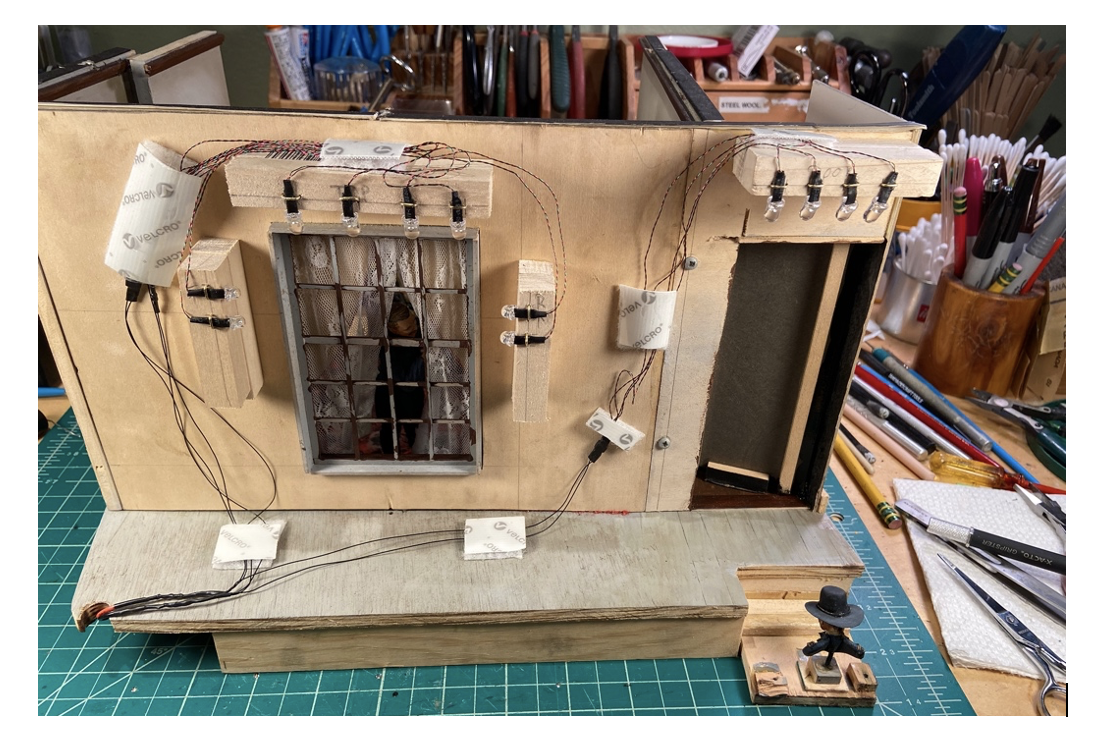From Sheperd Paine: The Life and Work of a Master Military Modeler and Historian by Jim DeRogatis (Schiffer Books, 2008)
J.D. Knowing your fondness for small touches, I would guess that the whole allure with “A Stillness at Appomattox” was showing Grant’s head and hat just outside the door.
S.P. No, that was strictly an afterthought. The portrait of Lee is the centerpiece of the box; everything else is window dressing. It’s essentially a portrait of Robert E. Lee at the most difficult moment of his life.
J.D. Was it difficult sculpting Lee’s likeness?
S.P. Lee is a bit like Lincoln: Once you get the hair and the beard right, the rest doesn’t matter that much. My research showed that at Appomattox, Lee wore the only coat he ever owned with gold knots on the sleeve. The coat is preserved in the Museum of the Confederacy in Richmond. I saw it and asked one of the curators about the provenance of the coat—how it was attributed to Appomattox—and he said that coat came from the Lee family and family tradition said it was worn at the surrender. It’s well-established that Lee wore his best coat, with his presentation sword and sash, which he rarely if ever wore. He fully expected to have to surrender his sword, because at the time of the Civil War, that formality was important.
J.D. Tell me about the setting.
S.P. This is the McLean house. Most history buffs are aware that the war started in Wilmer McLean’s front yard and ended in his front parlor. He had a house on the Bull Run battlefield, and he moved to Appomattox to get as far away from the war as possible. The room and its contents are well-documented. The pattern of the carpet and the furniture are modeled on the furnishings of the house at the time. The marble-top table next to Lee is in the Chicago Historical Society, so I went down to have a look at it.
The Confederate staff officer by the fireplace is Colonel Marshall, Lee’s chief of staff. He was one of the few officers of the time who actually wore glasses—that was at a time when if you had bad eyesight, you just didn’t see very well—and he is nervously polishing them. The Union officer by the window is Colonel Babcock, Grant’s aide de camp, who arranged the meeting. The three of them are biding time, waiting for General Grant to arrive. Edouard Detaille, the famous French military artist, observed that when painting history, quite often the moment before or the moment after an event is more telling that the moment itself.
J.D. You made that point very effectively in your diorama book.
S.P. This, I think, is a classic example of it, because the common artists’ image is of the surrender itself, but for me, the most poignant moment is when Lee is sitting, waiting for Grant. His army is at General Grant’s mercy and he knows he has no choice but to accept whatever terms Grant offers. He’s worried sick that the terms are going to be very hard on his soldiers—but it turned out they were not. I have always thought that Appomattox was the finest moment in American history: No other civil war ended with such grace, and a so little rancor, recrimination, or bloodshed.
Colonel Babcock is looking through the window, waiting for General Grant to arrive. When I thought about that, I realized that if I left the door slightly open, I could have General Grant coming up the steps. So Grant was very much an afterthought. He’s the Easter egg: a little touch you discover only after looking at it for a while.
J.D. Is there a whole Grant there?
S.P. No, just a head and shoulders.
I sculpted the couch, because I couldn’t find one that worked. The rag doll sitting on it was apparently a witness to the whole surrender, and some Union officer paid a small fortune for it. Those are dollhouse lace curtains. The lighting is simple, primarily sunlight through the window, with some cheater spotlights inside.
In May 2023, this box was sold at auction from the collection of the late Ralph Koebbeman. Jim DeRogatis purchased and restored it; here are his notes on that project.
The inner tray removed from the box, and with the ceiling taken off for access. This scene had a very tight fit in the box—I’m beginning to think the wood shrank on some of these, because “The Nightwatch” had the same problem—and rather than risk damaging something (like the back steps Shep added with the heads of Grant and an aide barely visible through the door), I gently sanded down the right edge to allow for an easier fit. Shep lit the scene with two rather large automotive bulbs, one on the reveal for the front, and one on the ceiling for the back. Below, you’ll see it took me 12 LEDs to get the bright sunlight he wanted coming in the window and door. (Grant accepted Lee’s surrender at midday on April 9, 1865, at the home of Wilmer McLean at Appomattox Court House.)
The new reveal with an additional seven LEDs to illuminate the front of the scene. I did not bother with spot tubes since the light was so bright in Shep’s scene, most of all on Lee at the center, but I did put those front lights on a dimmer. You can see it below behind the on/off toggle at the right of the cleaned-up interior of the box. (Boy, the inside of his boxes collected a lot of dust, dirt, and detritus over the years! This one dates to 1986.)







